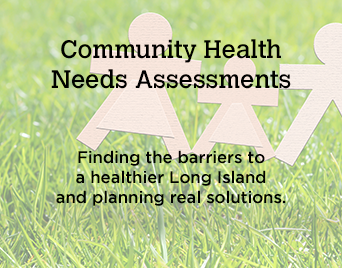Long Island Health Collaborative
The Long Island Health Collaborative (LIHC) is a voluntary coalition of nearly 300 organizations across Nassau and Suffolk Counties, all committed to improving the health of Long Islanders through collective impact. The LIHC’s membership consists of the region’s hospitals, both county health departments, numerous community-based health and social support service organizations, health plans, professional health provider associations, universities and school districts, public libraries, local municipalities, and numerous businesses that span many sectors.
The group employs a collective impact model which relies on the support and promotion of the many diverse programs and interventions each individual participant offers the community, as well as original interventions developed and implemented by the LIHC. Much of the Collaborative’s work is rooted in regionally addressing priorities outlined in the New York State Prevention Agenda. This is the state’s blueprint to reach its goal of becoming the healthiest state in the nation. The current two priorities driven by data and selected by consensus are:
- Prevent chronic diseases
- Promote well-being and prevent mental and substance use disorders
To learn about some of the exciting work the Collaborative is involved in, click on an initiative below.


The History of the Long Island Health Collaborative
The Long Island Health Collaborative initially began in 2013 as a homegrown response to the New York State Health Department’s urging that hospitals and county health departments conduct joint community health needs assessments. This followed on the heels of federal regulations contained in the 2010 Affordable Care Act that require this collaboration on community assessment. It is known as Section 501(r)(3)’s of the ACA.
How Community Health Assessment Happens
The Nassau-Suffolk Hospital Council, which represents hospitals on Long Island, brought the counties and hospitals together in 2013 to determine community needs. Assessing community needs is just what it says – connecting with residents, providers of health and social services, local municipalities and government leaders, and even businesses in a region – to discover what the most pressing health needs and barriers are. This exercise is known as a Community Health Needs Assessment (CHNA) for hospitals and a Community Health Assessment (CHA) for local county health departments. Through surveys, interviews, town halls, listening sessions and other forms of engagement the many voices of community members are heard. In addition, secondary data sources are reviewed to determine the socio-demographic factors of communities. This early iteration of the LIHC aimed to help NSHC member hospitals foster collaboration with health departments, community-based organizations, and other community stakeholders. All the data obtained was analyzed and compiled into an assessment report (CHNA for hospitals and CHA for local county health departments). This data then drove the selection of priorities and the resulting plans to address those priorities. Hospitals call it a Community Service Plan and local county health departments call it a Community Health Improvement Plan.
The first iteration of the state’s Prevention Agenda was the 2008-2012 cycle. Two other six-year cycles followed with preparation for the fourth six-year cycle underway – 2025-2030. In preparation for the first cycle, NSHC’s Communications Department successfully convened a robust group of hospital, health department, and community representatives, fulfilling the LIHC’s initial purpose and so much more. The group thrived, reaching 300+ participants today, and it continues to add new members each day. The synergy among the varied participants continued beyond the group’s initial call to action, resulting in routine meetings and the eventual designation as the Long Island Health Collaborative.
Guided by the New York State Prevention Agenda, the group chose two regional priorities on which to focus its collective efforts:
- Prevent chronic diseases
- Promote well-being and prevent mental and substance use disorders
With those priorities in mind, the group established as the core foundation of its collective efforts an emphasis on nutrition and physical activity. These two modifiable lifestyle behaviors can help individuals better manage both chronic illnesses and mental health/substance misuse. Many mental health disorders are chronic. Regarding physical activity, the group embraced walking as an evidence-based, low-cost, low-impact, and a nearly universally available form of physical activity in which all members of a community can engage. The many physical and mental health benefits of walking are well-documented and include the prevention and mitigation of chronic mental and physical conditions.
Always Data Driven
From its founding, thee LIHC developed a Community Health Assessment Survey (CHAS) in collaboration with its members to gauge individuals’ perception about their own and their community’s health needs and barriers. This survey is still in use today and results are analyzed on an annual basis. The CHAS, along with themed data reports and primary field research and examination of various secondary datasets, informs cyclical Prevention Agenda priorities. The two priorities have remained the same since 2013. LIHC staff prepare a CHNA/CHA report template for participants to utilize at their own discretion for use in meeting state Prevention Agenda needs and federal community benefit requirements. The template contains all required elements of a CHNA/CHA in the form of a comprehensive narrative, including relevant primary and secondary supporting data.
It’s All about Networking
Nothing substantial gets done in a silo and so the networking opportunity that the LIHC offers its diverse partners has resulted in many unique partnerships and projects throughout the years. Networking and convening remain a cornerstone of the LIHC’s commitment to the collective impact model and improvement of health for all Long Islanders.
What about Funding Sources?
The LIHC began as an unfunded, voluntary effort overseen by the NSHC and that remains true today. However, in 2014, the LIHC applied to the New York State Department of Health Population Health Improvement Program (PHIP). The application was successful and the LIHC, under the oversight of the Nassau-Suffolk Hospital Council, secured funding for a five-year period – 2015-2020. The state did not renew the PHIP program, which existed in 11 regions in the state to oversee and manage population health activities from a multi-sector collaborative approach. The LIHC served as the PHIP for the Long Island region.
The LIHC’s network meetings and programming went virtual in 2020 when the pandemic struck but it nonetheless enjoyed robust participation at meetings. Now, post-pandemic, the LIHC meets in a hybrid fashion with a focus on cultural competency/health literacy, chronic disease, and mental health. It will continue to meet and work to address collective regional health priorities as demonstrated by data and empirical evidence.